Deep Learning-Based Growth Prediction System: A Use Case of China Agriculture
Abstract
1. Introduction
2. Materials and Methods
2.1. Spatial Prediction
2.2. Logistic Regression Model
2.3. SVM Regression
2.4. AdaBoost
2.5. Multilayer Perceptron Neural Network
2.6. Agricultural Deep Learning (AGR-DL)
2.7. Method Renovation and Evaluation
2.8. Experimental Dataset
3. Results
3.1. Apple Production
3.2. Citrus Production
3.3. Pear Production
3.4. Grape Production
3.5. Banana Production
3.6. Comparison of Study
4. Discussion and Recommendations
5. Conclusions
Author Contributions
Funding
Conflicts of Interest
Abbreviations
References
- Niazian, M.; Niedbała, G. Machine Learning for Plant Breeding and Biotechnology. Agriculture 2020, 10, 436. [Google Scholar] [CrossRef]
- Liakos, K.; Busato, P.; Moshou, D.; Pearson, S.; Bochtis, D. Machine Learning in Agriculture: A Review. Sensors 2018, 18, 2674. [Google Scholar] [CrossRef] [PubMed]
- Darwin, B.; Dharmaraj, P.; Prince, S.; Popescu, D.E.; Hemanth, D.J. Recognition of Bloom/Yield in Crop Images Using Deep Learning Models for Smart Agriculture: A Review. Agronomy 2021, 11, 646. [Google Scholar] [CrossRef]
- Dias, P.A.; Tabb, A.; Medeiros, H. Apple flower detection using deep convolutional networks. Comput. Ind. 2018, 99, 17–28. [Google Scholar] [CrossRef]
- Pereira, T.D.; Aldarondo, D.E.; Willmore, L.; Kislin, M.; Wang, S.S.-H.; Murthy, M.; Shaevitz, J.W. Fast animal pose estimation using deep neural networks. Nat. Methods 2018, 16, 117–125. [Google Scholar] [CrossRef] [PubMed]
- Wang, J.; Mendelsohn, R.; Dinar, A.; Huang, J. How chinese farmers change crop choice to adapt to climate change. Clim. Chang. Econ. 2010, 1, 167–185. [Google Scholar] [CrossRef]
- Huang, Z.; Liang, Q. Agricultural organizations and the role of farmer cooperatives in China since 1978: Past and future. China Agric. Econ. Rev. 2018, 10, 48–64. [Google Scholar] [CrossRef]
- Zarifneshat, S.; Rohani, A.; Ghassemzadeh, H.R.; Sadeghi, M.; Ahmadi, E.; Zarifneshat, M. Predictions of apple bruise volume using artificial neural network. Comput. Electron. Agric. 2012, 82, 75–86. [Google Scholar] [CrossRef]
- Zhao, R.; Li, Y.; Ma, M. Mapping Paddy Rice with Satellite Remote Sensing: A Review. Sustainability 2021, 13, 503. [Google Scholar] [CrossRef]
- Murat, Y.S.; Ceylan, H. Use of artificial neural networks for transport energy demand modeling. Energy Policy 2006, 34, 3165–3172. [Google Scholar] [CrossRef]
- Li, W.; Yang, M.; Wang, J.; Wang, Z.; Fan, Z.; Kang, F.; Wang, Y.; Luo, Y.; Kuang, D.; Chen, Z.; et al. Agronomic Responses of Major Fruit Crops to Fertilization in China: A Meta-Analysis. Agronomy 2020, 10, 15. [Google Scholar] [CrossRef]
- Cherian, R.P.; Smith, L.N.; Midha, P.S. A neural network approach for selection of powder metallurgy materials and process parameters. Artif. Intell. Eng. 2000, 14, 39–44. [Google Scholar] [CrossRef]
- Smith, L.N.; German, R.M.; Smith, M.L. A neural network approach for solution of the inverse problem for selection of powder metallurgy materials. J. Mater. Process. Technol. 2002, 120, 419–425. [Google Scholar] [CrossRef]
- Sanzogni, L.; Kerr, D. Milk production estimates using feed forward artificial neural networks. Comput. Electron. Agric. 2001, 32, 21–30. [Google Scholar] [CrossRef]
- Korosec, M.; Balic, J.; Kopac, J. Neural network based manufacturability evaluation of free form machining. Int. J. Mach. Tools Manuf. 2005, 45, 13–20. [Google Scholar] [CrossRef]
- Hu, R.; Yang, Z.; Kelly, P.; Huang, J. Agricultural extension system reform and agent time allocation in China. China Econ. Rev. 2009, 20, 303–315. [Google Scholar] [CrossRef]
- Agrawal, D.; Schorling, C. Market share forecasting: An empirical comparison of artificial neural networks and multinomial logit model. J. Retail. 1996, 72, 383–407. [Google Scholar] [CrossRef]
- Co, H.C.; Boosarawongse, R. Forecasting Thailand’s rice export: Statistical techniques vs. artificial neural networks. Comput. Ind. Eng. 2007, 53, 610–627. [Google Scholar] [CrossRef]
- Ali, A.; Imran, M.M. Evaluating the potential of red edge position (R.E.P.) of hyperspectral remote sensing data for real time estimation of LAI & chlorophyll content of kinnow mandarin (Citrus reticulata) fruit orchards. Sci. Hortic. 2020, 267, 109326. [Google Scholar] [CrossRef]
- Vakil-Baghmisheh, M.-T.; Pavešić, N. A Fast Simplified Fuzzy ARTMAP Network. Neural Process. Lett. 2003, 17, 273–316. [Google Scholar] [CrossRef]
- Friis, C.; Nielsen, J.Ø. Small-scale land acquisitions, large-scale implications: Exploring the case of Chinese banana investments in Northern Laos. Land Use Policy 2016, 57, 117–129. [Google Scholar] [CrossRef]
- Viani, F.; Bertolli, M.; Salucci, M.; Polo, A. Low-Cost Wireless Monitoring and Decision Support for Water Saving in Agriculture. IEEE Sens. J. 2017, 17, 4299–4309. [Google Scholar] [CrossRef]
- McIntosh, R.B.; Casada, M.E. Fringing Field Capacitance Sensor for Measuring the Moisture Content of Agricultural Commodities. IEEE Sens. J. 2008, 8, 240–247. [Google Scholar] [CrossRef]
- Ochiai, H.; Ishizuka, H.; Kawakami, Y.; Esaki, H. A DTN-Based Sensor Data Gathering for Agricultural Applications. IEEE Sens. J. 2011, 11, 2861–2868. [Google Scholar] [CrossRef]
- Kone, C.T.; Hafid, A.; Boushaba, M. Performance Management of IEEE 802.15.4 Wireless Sensor Network for Precision Agriculture. IEEE Sens. J. 2015, 15, 5734–5747. [Google Scholar] [CrossRef]
- Biffi, L.J.; Mitishita, E.; Liesenberg, V.; Santos, A.A.D.; Gonçalves, D.N.; Estrabis, N.V.; Silva, J.D.A.; Osco, L.P.; Ramos, A.P.M.; Centeno, J.A.S.; et al. ATSS Deep Learning-Based Approach to Detect Apple Fruits. Remote Sens. 2021, 13, 54. [Google Scholar] [CrossRef]
- Wang, L.; Zhou, Y.; Li, Q.; Xu, T.; Wu, Z.; Liu, J. Application of Three Deep Machine-Learning Algorithms in a Construction Assessment Model of Farmland Quality at the County Scale: Case Study of Xiangzhou, Hubei Province, China. Agriculture 2021, 11, 72. [Google Scholar] [CrossRef]
- Abbas, F.; Afzaal, H.; Farooque, A.A.; Tang, S. Crop Yield Prediction through Proximal Sensing and Machine Learning Algorithms. Agronomy 2020, 10, 1046. [Google Scholar] [CrossRef]
- Kuznetsova, A.; Maleva, T.; Soloviev, V. Using YOLOv3 Algorithm with Pre- and Post-Processing for Apple Detection in Fruit-Harvesting Robot. Agronomy 2020, 10, 1016. [Google Scholar] [CrossRef]
- Zhang, L.; Kono, Y.; Kobayashi, S. The process of expansion in commercial banana cropping in tropical China: A case study at a Dai village, Mengla County. Agric. Syst. 2014, 124, 32–38. [Google Scholar] [CrossRef]
- Jang, Y.M.; Mallipeddi, R.; Lee, M. Exogenous and Endogenous Based Spatial Attention Analysis for Human Implicit Intention Understanding. In Neural Information Processing: ICONIP 2013; Lecture Notes in Computer, Science; Lee, M., Hirose, A., Hou, Z.G., Kil, R.M., Eds.; Springer: Berlin/Heidelberg, Germany, 2013; Volume 8226. [Google Scholar]
- Prodanova, K.; Negreva, M.; Vitlianova, K. Diagnostic Values of Some Fibrinolytic Indicators for Rejecting the Presence of Paroxysmal Atrial Fibrillation. Int. J. Basic Sci. Appl. Comput. 2020, 2, 1–6. [Google Scholar] [CrossRef]
- Møller, M.F. A scaled conjugate gradient algorithm for fast supervised learning. Neural Netw. 1993, 6, 525–533. [Google Scholar] [CrossRef]
- Dan Foresee, F.; Hagan, M.T. Gauss-Newton approximation to Bayesian learning. In Proceedings of the International Conference on Neural Networks (ICNN’97), Houston, TX, USA, 12 June 1997. [Google Scholar] [CrossRef]
- Freund, Y.; Schapire, R.E. A Decision-Theoretic Generalization of On-Line Learning and an Application to Boosting. J. Comput. Syst. Sci. 1997, 55, 119–139. [Google Scholar] [CrossRef]
- Yu, C.; Liu, B. A backpropagation algorithm with adaptive learning rate and momentum coefficient. In Proceedings of the 2002 International Joint Conference on Neural Networks, Honolulu, HI, USA, 12–17 May 2002. [Google Scholar] [CrossRef]
- He, K.; Zhang, X.; Ren, S.; Sun, J. Deep Residual Learning for Image Recognition. In Proceedings of the 2016 IEEE Conference on Computer Vision and Pattern Recognition (CVPR), Las Vegas, NV, USA, 27–30 June 2016; pp. 770–778. [Google Scholar] [CrossRef]
- Shen, Y.; Yin, Y.; Zhao, C.; Li, B.; Wang, J.; Li, G.; Zhang, Z. Image Recognition Method Based on an Improved Convolutional Neural Network to Detect Impurities in Wheat. IEEE Access 2019, 7, 162206–162218. [Google Scholar] [CrossRef]
- Powers, D.M.W. Evaluation: From precision, Recall and F-Measure to ROC, Informedness, Markedness & correlation. J. Mach. Learn. Technol. 2011, 2, 37–63. [Google Scholar] [CrossRef]
- FAO. World Food and Agriculture—Statistical Yearbook 2020; FAO: Rome, Italy, 2020. [Google Scholar]
- Rehman, A.; Deyuan, Z.; Hussain, I.; Iqbal, M.S.; Yang, Y.; Jingdong, L. Prediction of Major Agricultural Fruits Production in Pakistan by Using an Econometric Analysis and Machine Learning Technique. Int. J. Fruit Sci. 2018, 18, 445–461. [Google Scholar] [CrossRef]
- Miraglia, M.; Marvin, H.J.P.; Kleter, G.A.; Battilani, P.; Brera, C.; Coni, E.; Cubadda, F.; Croci, L.; De Santis, B.; Vespermann, A.; et al. Climate change and food safety: An emerging issue with special focus on Europe. Food Chem. Toxicol. 2009, 47, 1009–1021. [Google Scholar] [CrossRef]
- Nordhaus, W.D. A Review of the Stern Review on the Economics of Climate Change. J. Econ. Lit. 2007, 45, 686–702. [Google Scholar] [CrossRef]
- Supit, I.; van Diepen, C.A.; de Wit, A.J.W.; Kabat, P.; Baruth, B.; Ludwig, F. Recent changes in the climatic yield potential of various crops in Europe. Agric. Syst. 2010, 103, 683–694. [Google Scholar] [CrossRef]
- Olesen, J.E.; Trnka, M.; Kersebaum, K.C.; Skjelvåg, A.O.; Seguin, B.; Peltonen-Sainio, P.; Rossi, F.; Kozyra, J.; Micale, F. Impacts and adaptation of European crop production systems to climate change. Eur. J. Agron. 2011, 34, 96–112. [Google Scholar] [CrossRef]
- Winterbourn, M.J.; Cadbury, S.; Ilg, C.; Milner, A.M. Mayfly production in a New Zealand glacial stream and the potential effect of climate change. Hydrobiologia 2008, 603, 211–219. [Google Scholar] [CrossRef]
- Wang, L.; Huo, X. Willingness-to-pay price premiums for certified fruits—A case of fresh apples in China. Food Control. 2016, 64, 240–246. [Google Scholar] [CrossRef]
- Ma, W.; Abdulai, A. Does cooperative membership improve household welfare? Evidence from apple farmers in China. Food Policy 2016, 58, 94–102. [Google Scholar] [CrossRef]
- Guan, X.; Tan, S.; Buchholz, G.; Peter, N.; Zhou, Z. A method to evaluate the bioactive function of fruit extracts of Chinese wild Citrus with microtubular activity. J. Integr. Agric. 2017, 16, 867–873. [Google Scholar] [CrossRef][Green Version]
- Wang, Y.; Wang, Y.; Wang, J.; Yuan, Y.; Zhang, Z. An ontology-based approach to integration of hilly citrus production knowledge. Comput. Electron. Agric. 2015, 113, 24–43. [Google Scholar] [CrossRef]
- Li, Q.; He, F.; Zhu, B.-Q.; Liu, B.; Sun, R.-Z.; Duan, C.-Q.; Reeves, M.J.; Wang, J. Comparison of distinct transcriptional expression patterns of flavonoid biosynthesis in Cabernet Sauvignon grapes from east and west China. Plant Physiol. Biochem. 2014, 84, 45–56. [Google Scholar] [CrossRef] [PubMed]
- Crozier, S.J.; Preston, A.G.; Hurst, J.W.; Payne, M.J.; Mann, J.; Hainly, L.; Miller, D.L. Cacao seeds are a “Super Fruit”: A comparative analysis of various fruit powders and products. Chem. Cent. J. 2011, 5, 5. [Google Scholar] [CrossRef]
- Abdul, R.; Zhang, D.; Luan, J. The Production and prediction of major chinese agricultural fruits using an econometric analysis and machine learning technique. Afr. J. Agric. Res. 2018, 13, 2134–2145. [Google Scholar] [CrossRef]
- Bresilla, K.; Perulli, G.D.; Boini, A.; Morandi, B.; Corelli Grappadelli, L.; Manfrini, L. Single-Shot Convolution Neural Networks for Real-Time Fruit Detection Within the Tree. Front. Plant Sci. 2019, 10, 611. [Google Scholar] [CrossRef]
- Khan, T.; Qiu, J.; Banjar, A.; Alharbey, R.; Alzahrani, A.O.; Mehmood, R. Effect of climate change on fruit by co-integration and machine learning. Int. J. Clim. Chang. Strateg. Manag. 2021. ahead-of-print. [Google Scholar] [CrossRef]
- Chung, D.T.P.; van Tai, D. A fruits recognition system based on a modern deep learning technique. J. Phys. Conf. Ser. 2019, 1327, 012050. [Google Scholar] [CrossRef]
- Khan, T.; Qiu, J.; Qureshi, M.A.A.; Iqbal, M.S.; Mehmood, R.; Hussain, W. Agricultural Fruit Prediction Using Deep Neural Networks. Procedia Comput. Sci. 2020, 174, 72–78. [Google Scholar] [CrossRef]
- Arab, T.S.; Noguchi, R.; Matsushita, S.; Ahamed, T. Prediction of grape yields from time-series vegetation indices using satellite remote sensing and a machine-learning approach. Remote Sens. Appl. Soc. Environ. 2021, 22, 100485. [Google Scholar] [CrossRef]
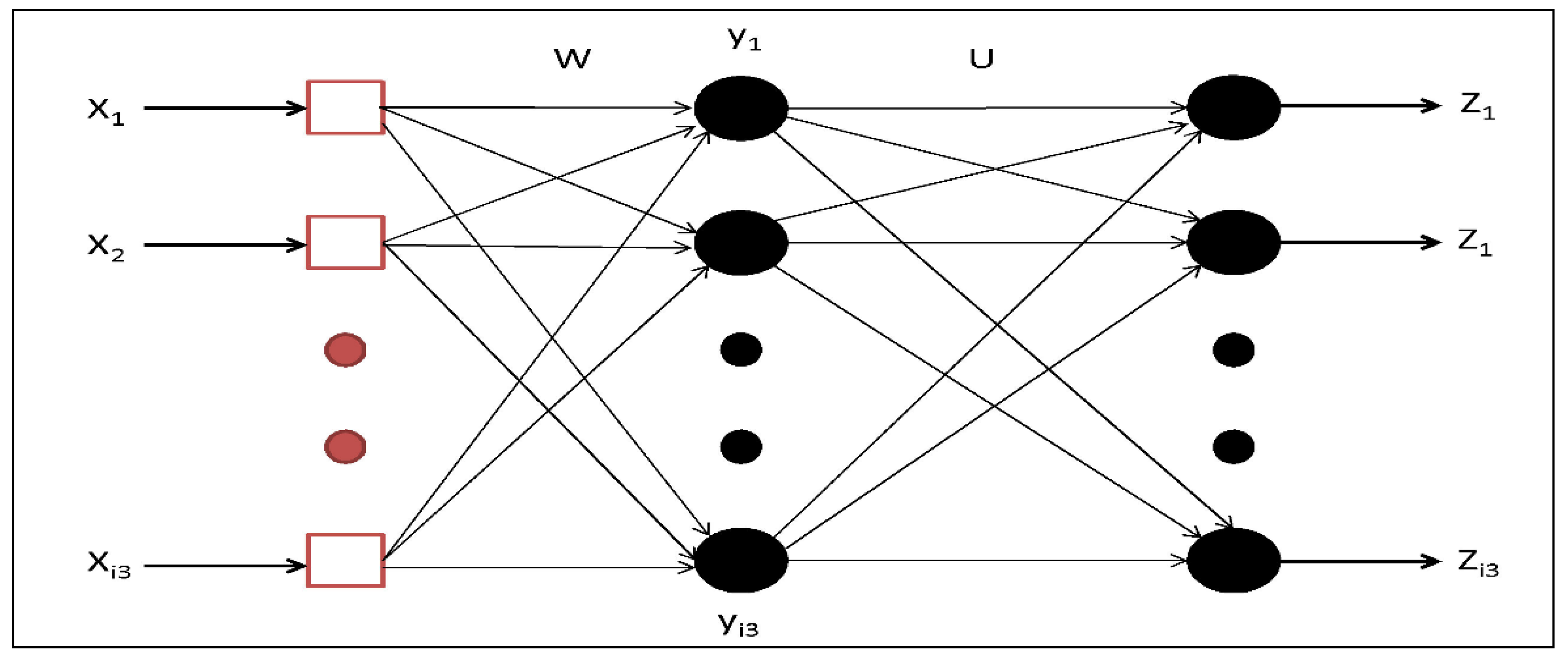
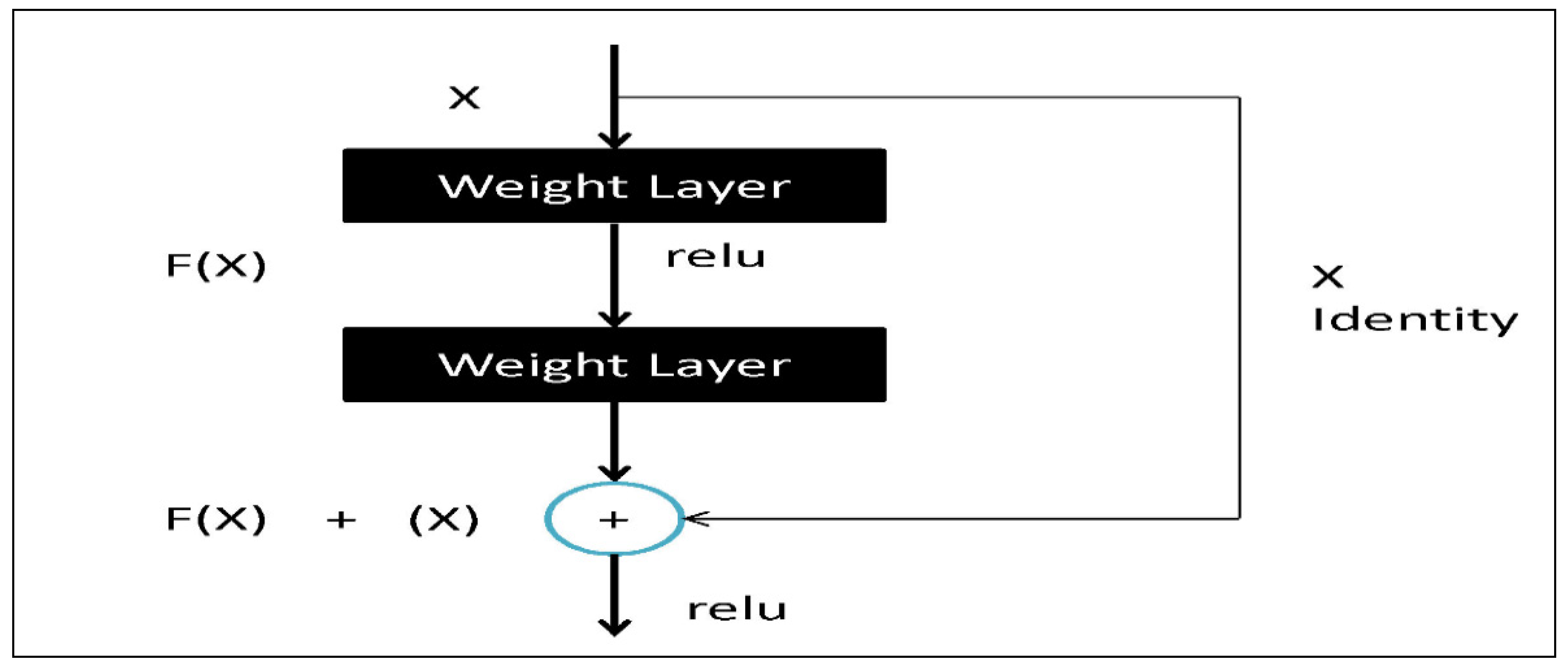
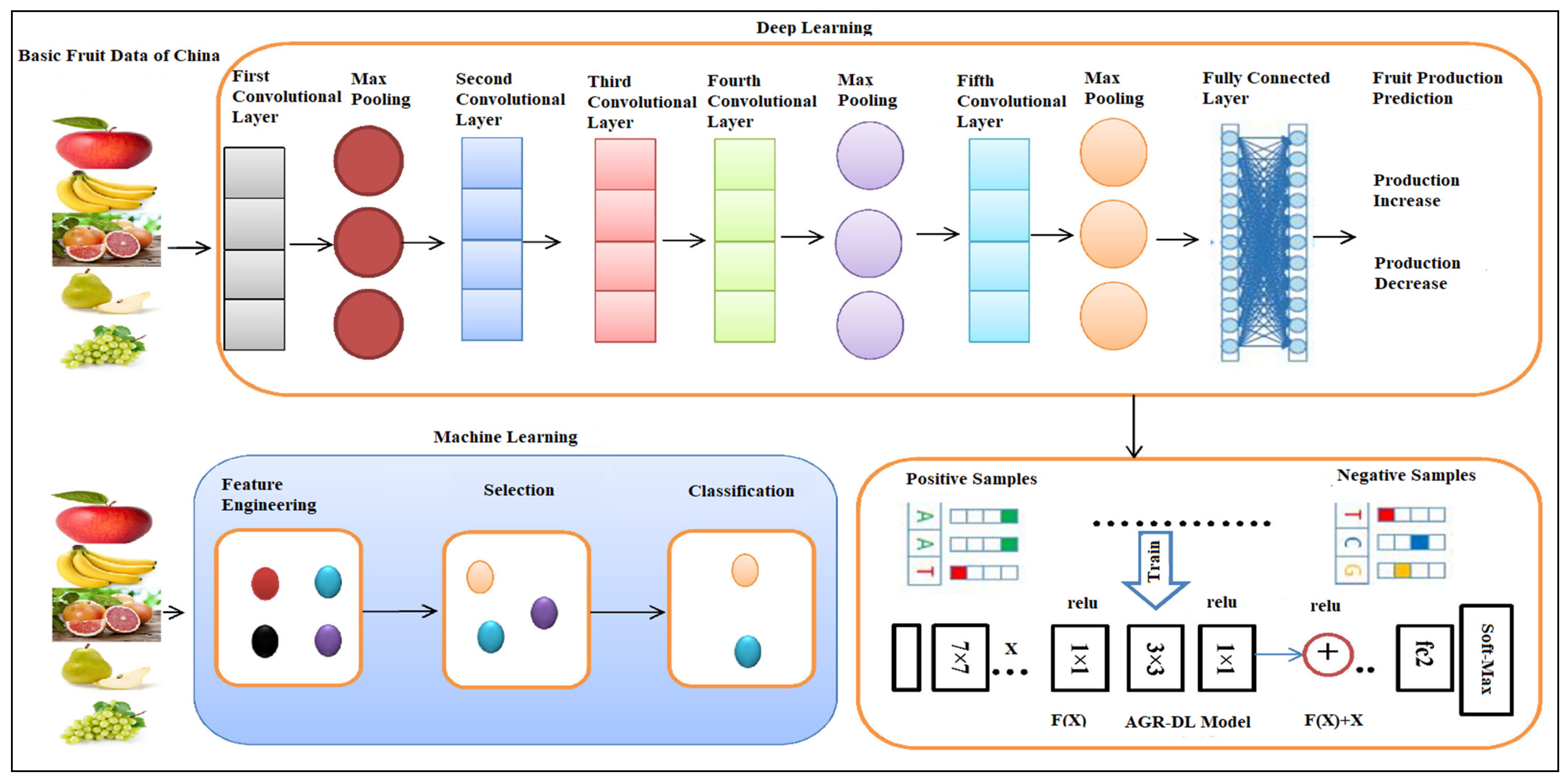
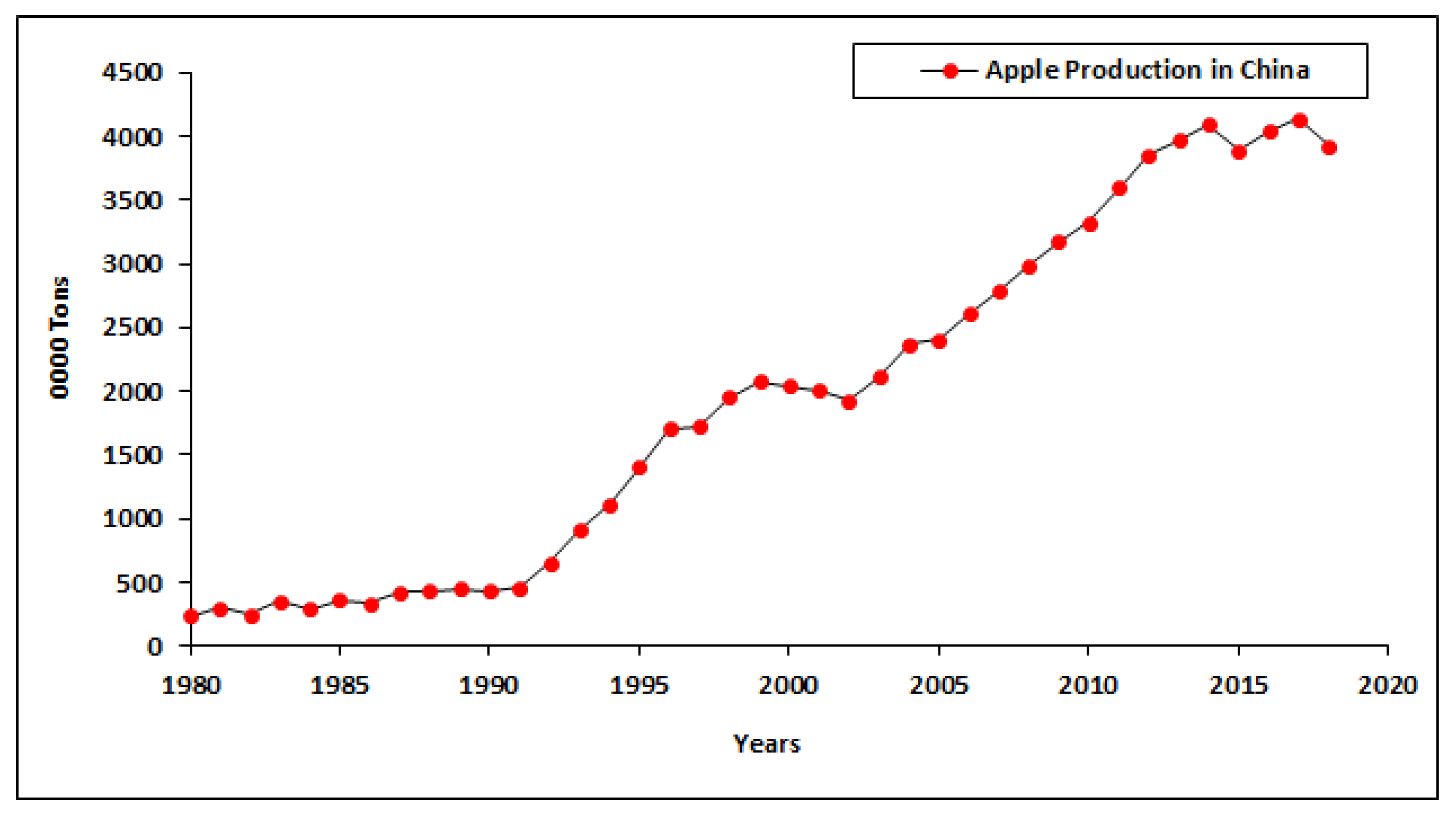
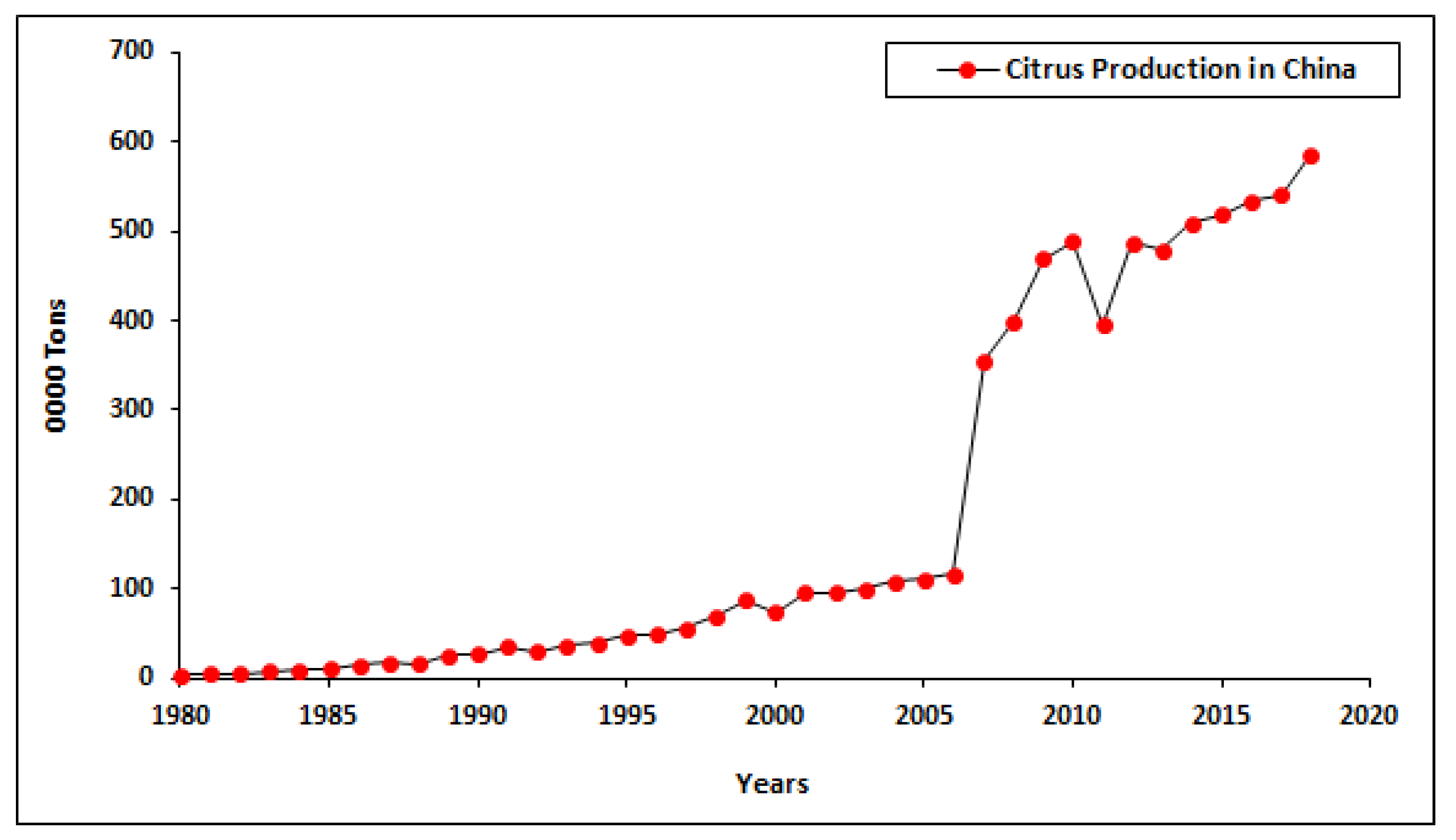

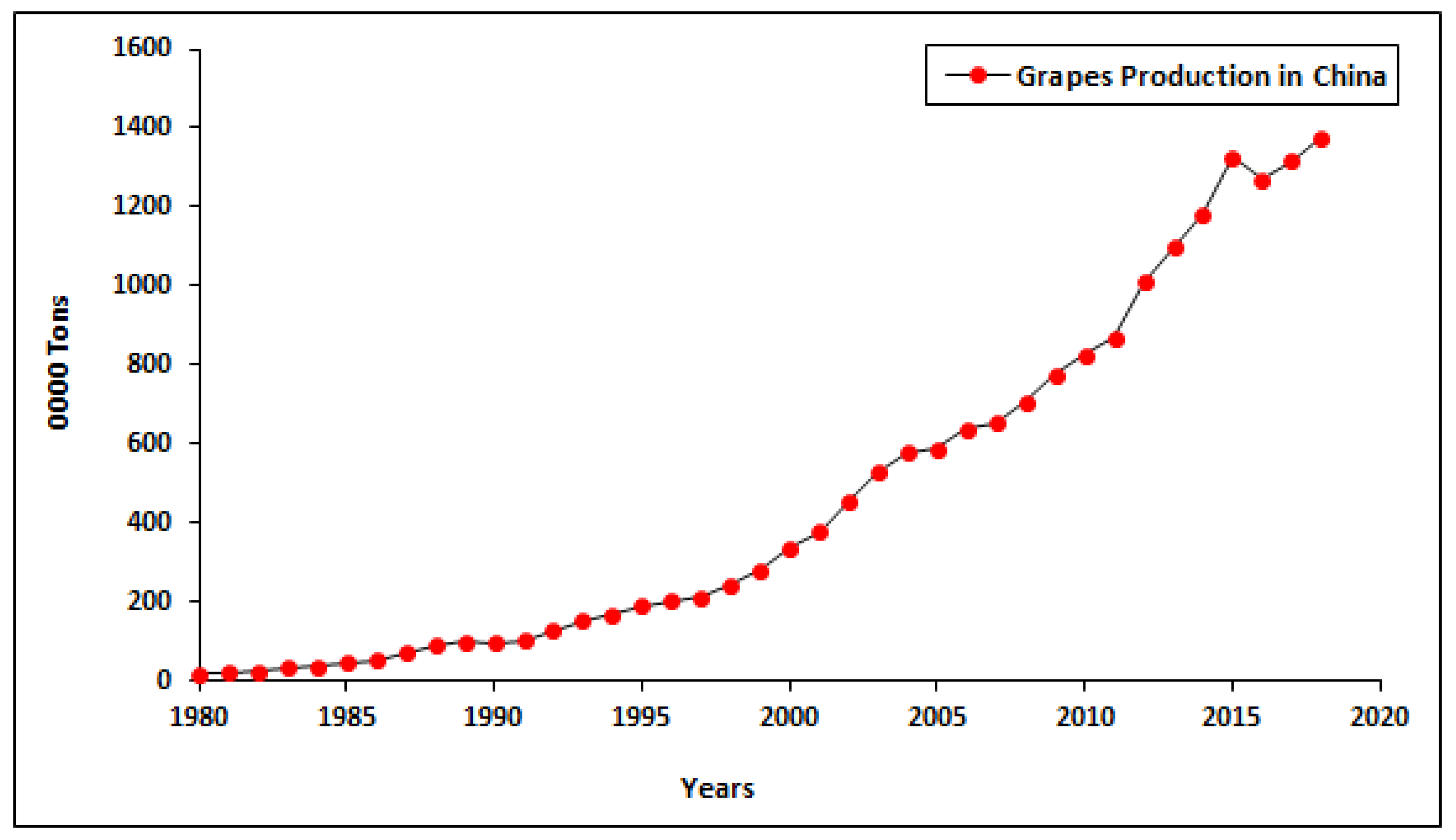
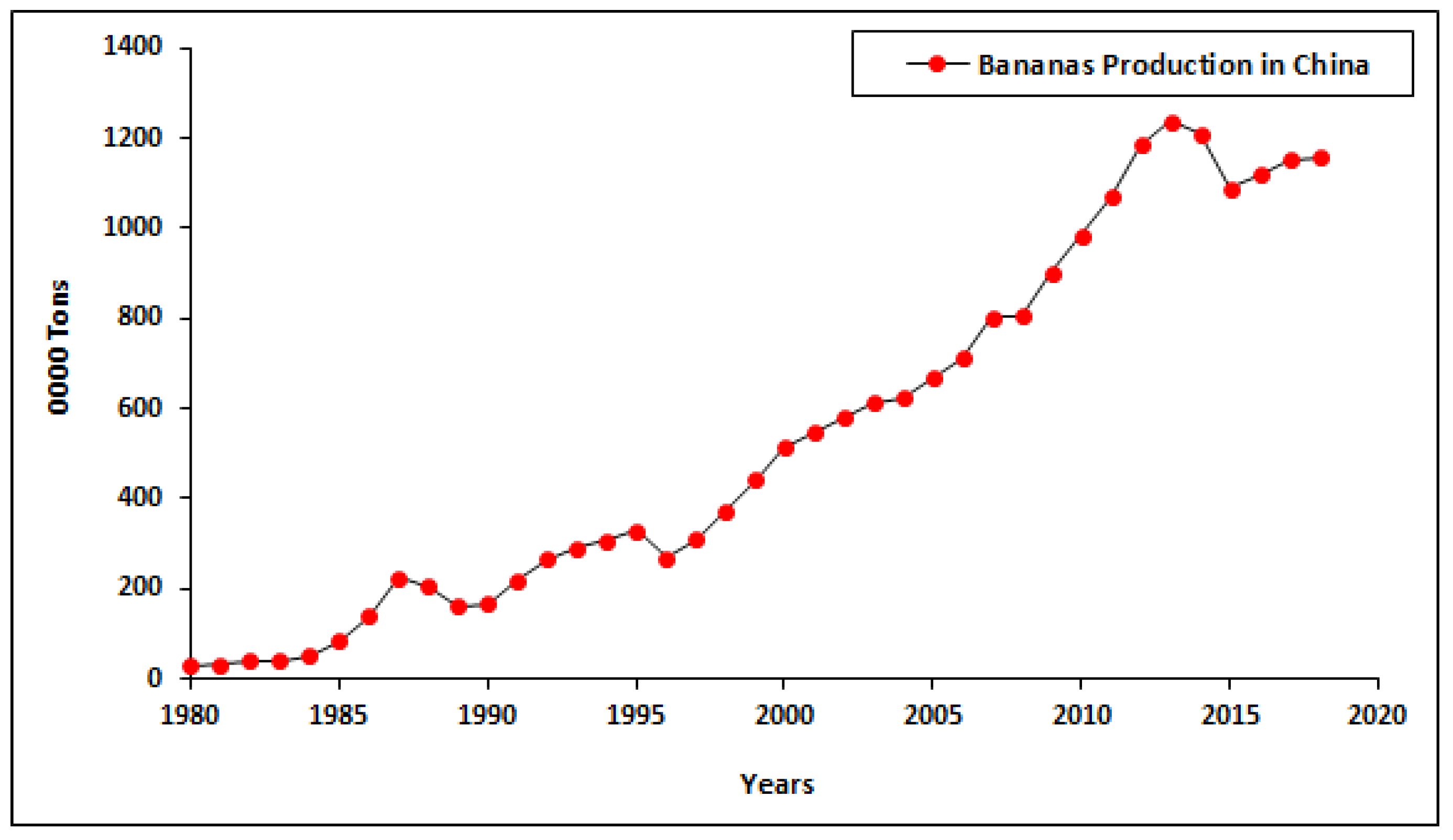
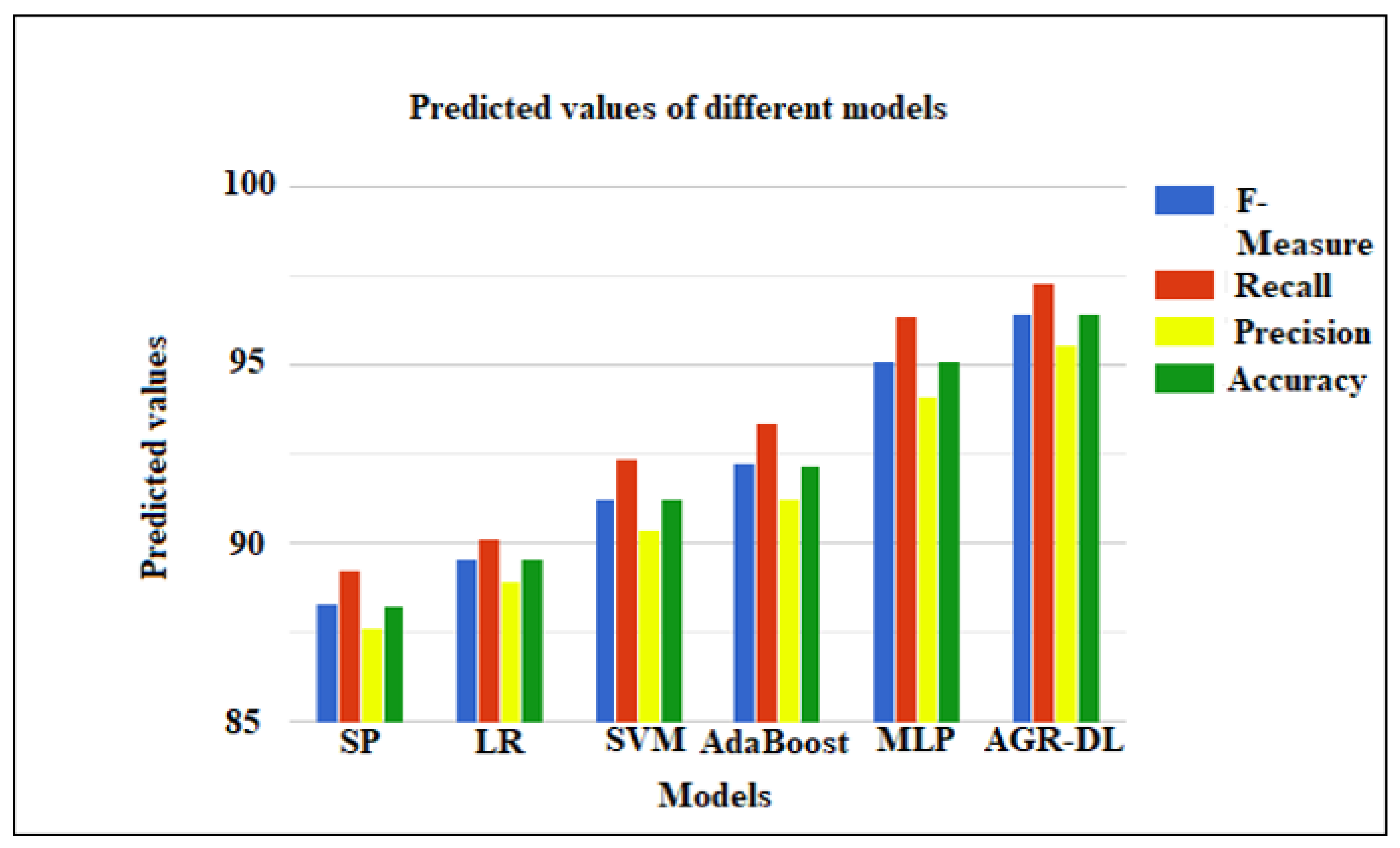


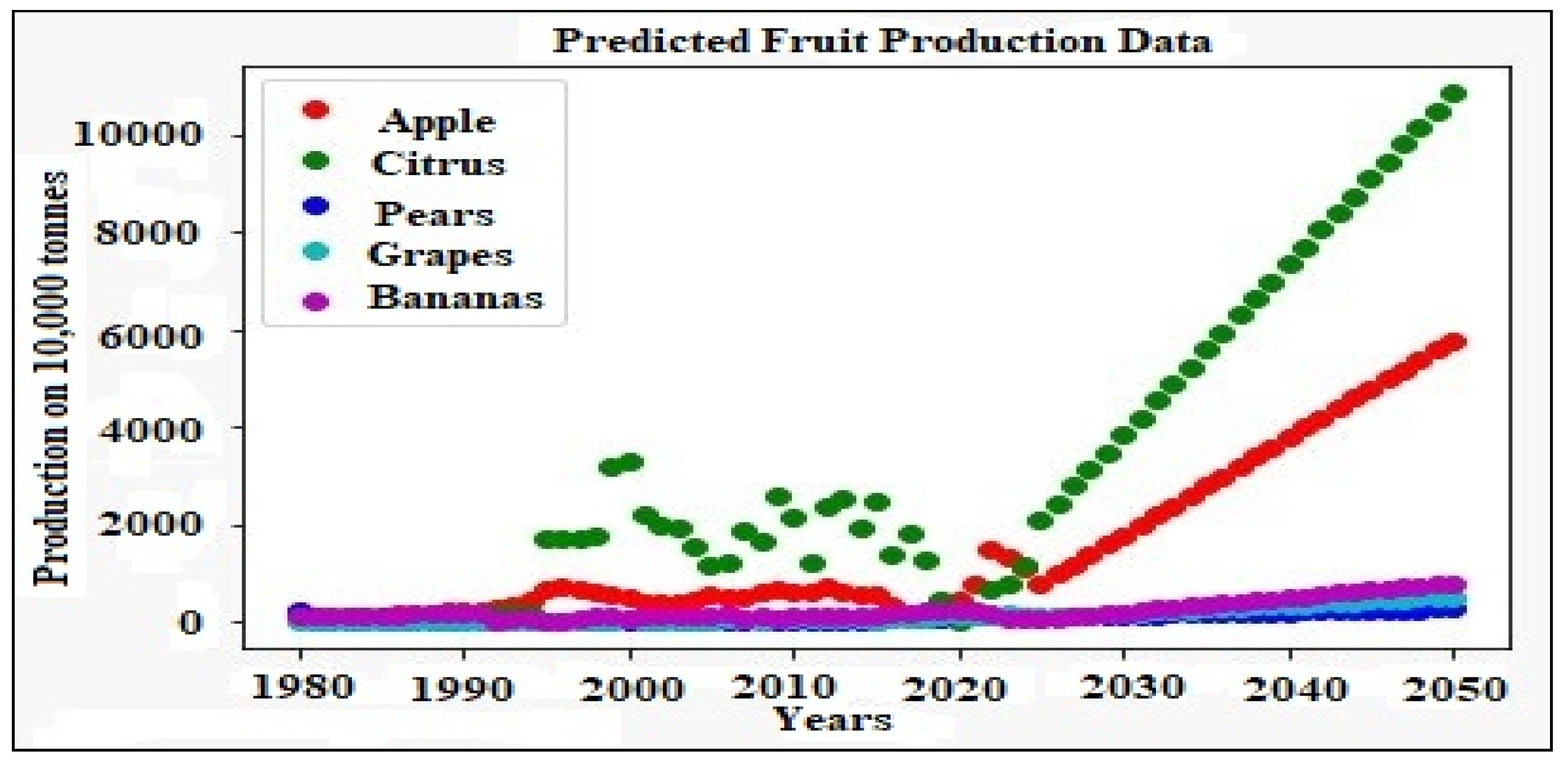
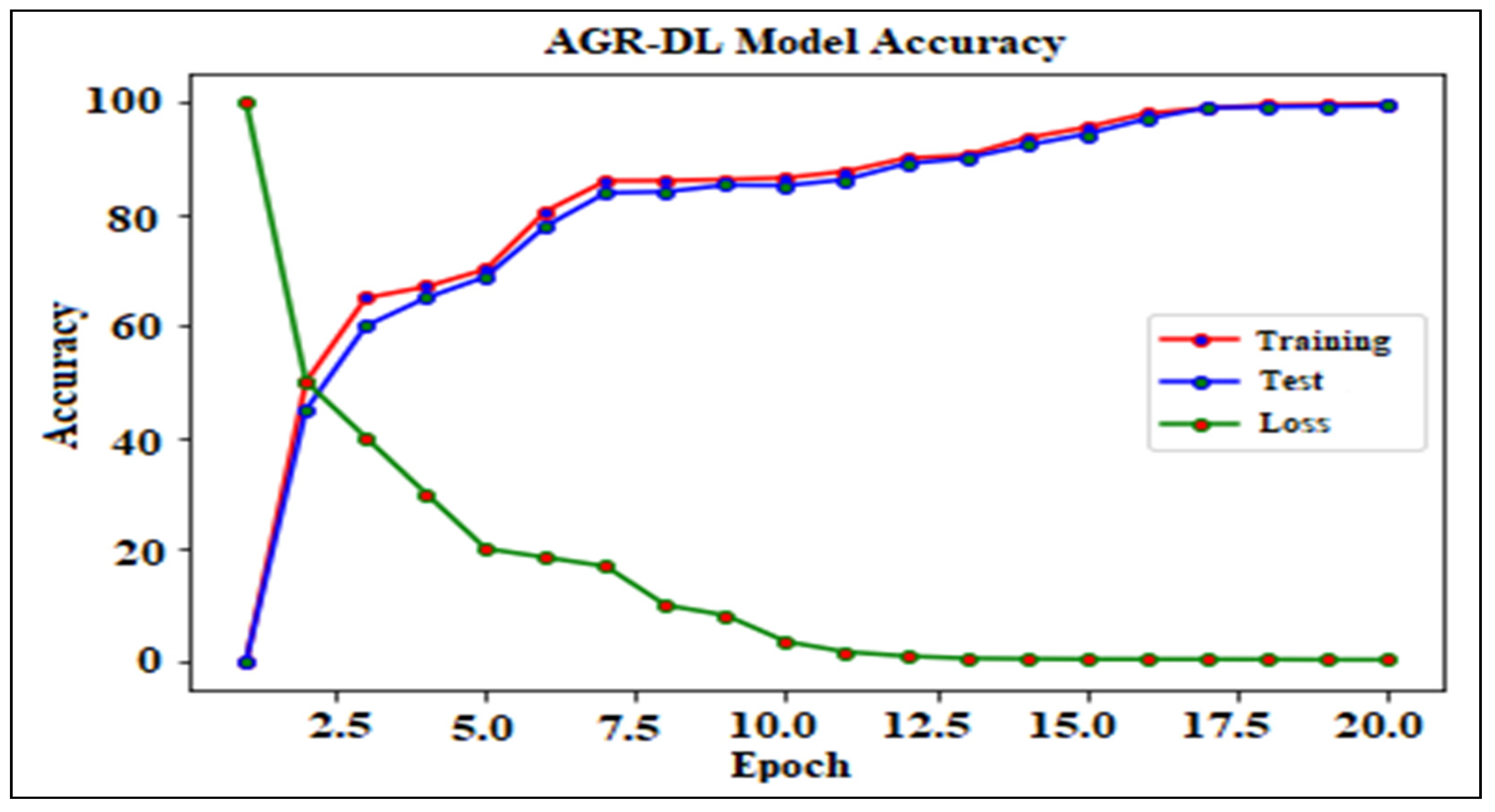
| Fruit Type | Training Data | Predicted Data | Production (10,000 tons) |
|---|---|---|---|
| Apples | 1980–2018 | 2019–2050 | 4131.4 |
| Bananas | 1980–2018 | 2019–2050 | 3556.3 |
| Citrus | 1980–2018 | 2019–2050 | 1798.8 |
| Pears | 1980–2018 | 2019–2050 | 1353.6 |
| Grapes | 1980–2018 | 2019–2050 | 1150.40 |
| Study | Predicted Dataset | Recall | Accuracy | F-Measure | Precision |
|---|---|---|---|---|---|
| [53] | 1980–2030 | X | 51.26 ± 1 | X | X |
| AGR-DL | 1980–2050 | 97.34 ± 2% | 96.42 ± 2% | 96.43 ± 2% | 95.56 ± 2% |
| Models | Predicted Data | Recall | Accuracy | F-Measure | Precision (%) |
|---|---|---|---|---|---|
| SP | 1980–2050 | 89.25 | 88.28 | 88.29 | 87.65 ± 2% |
| LR | 1980–2050 | 90.14 | 89.56 | 89.57 | 88.96 ± 2% |
| SVM | 1980–2050 | 92.37 | 91.23 | 91.24 | 90.37 ± 2% |
| AdaBoost | 1980–2050 | 93.36 | 92.21 | 92.25 | 91.23 ± 2% |
| MLP | 1980–2050 | 96.39 | 95.13 | 95.14 | 94.12 ± 2% |
| AGR-DL | 1980–2050 | 97.34 | 96.42 | 96.43 | 95.56 ± 2% |
Publisher’s Note: MDPI stays neutral with regard to jurisdictional claims in published maps and institutional affiliations. |
© 2021 by the authors. Licensee MDPI, Basel, Switzerland. This article is an open access article distributed under the terms and conditions of the Creative Commons Attribution (CC BY) license (https://creativecommons.org/licenses/by/4.0/).
Share and Cite
Khan, T.; Sherazi, H.H.R.; Ali, M.; Letchmunan, S.; Butt, U.M. Deep Learning-Based Growth Prediction System: A Use Case of China Agriculture. Agronomy 2021, 11, 1551. https://doi.org/10.3390/agronomy11081551
Khan T, Sherazi HHR, Ali M, Letchmunan S, Butt UM. Deep Learning-Based Growth Prediction System: A Use Case of China Agriculture. Agronomy. 2021; 11(8):1551. https://doi.org/10.3390/agronomy11081551
Chicago/Turabian StyleKhan, Tamoor, Hafiz Husnain Raza Sherazi, Mubashir Ali, Sukumar Letchmunan, and Umair Muneer Butt. 2021. "Deep Learning-Based Growth Prediction System: A Use Case of China Agriculture" Agronomy 11, no. 8: 1551. https://doi.org/10.3390/agronomy11081551
APA StyleKhan, T., Sherazi, H. H. R., Ali, M., Letchmunan, S., & Butt, U. M. (2021). Deep Learning-Based Growth Prediction System: A Use Case of China Agriculture. Agronomy, 11(8), 1551. https://doi.org/10.3390/agronomy11081551








